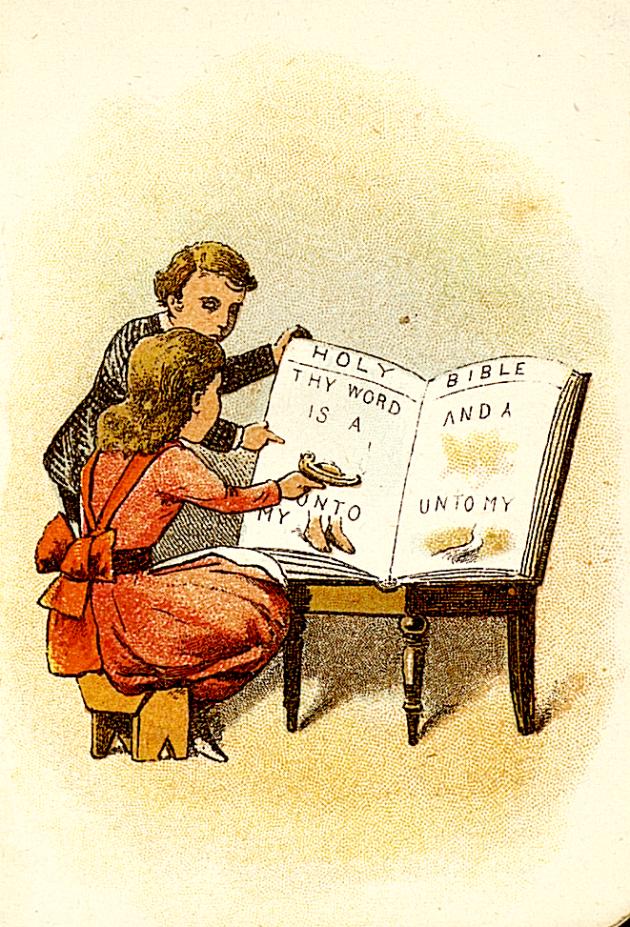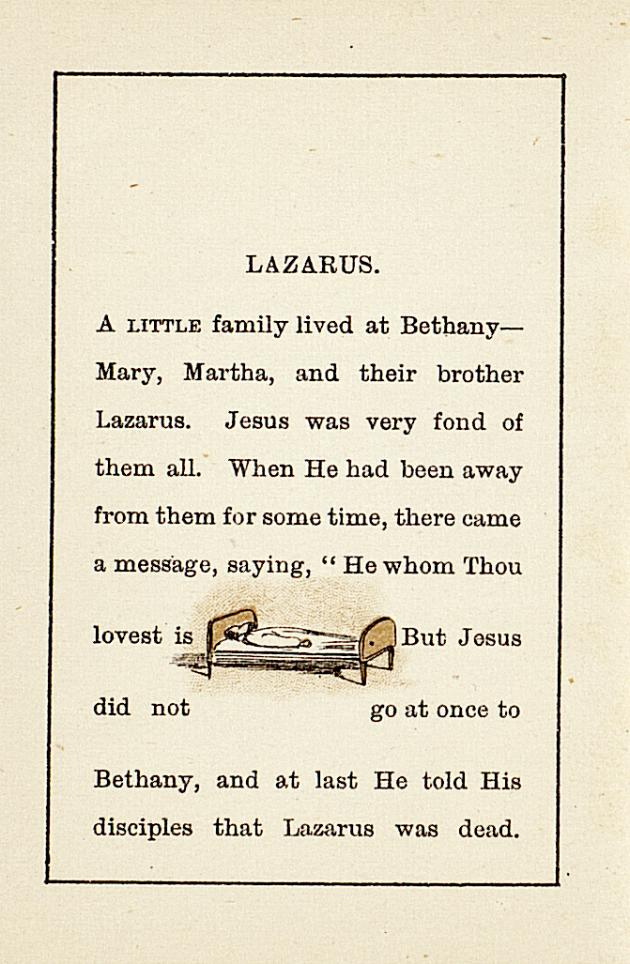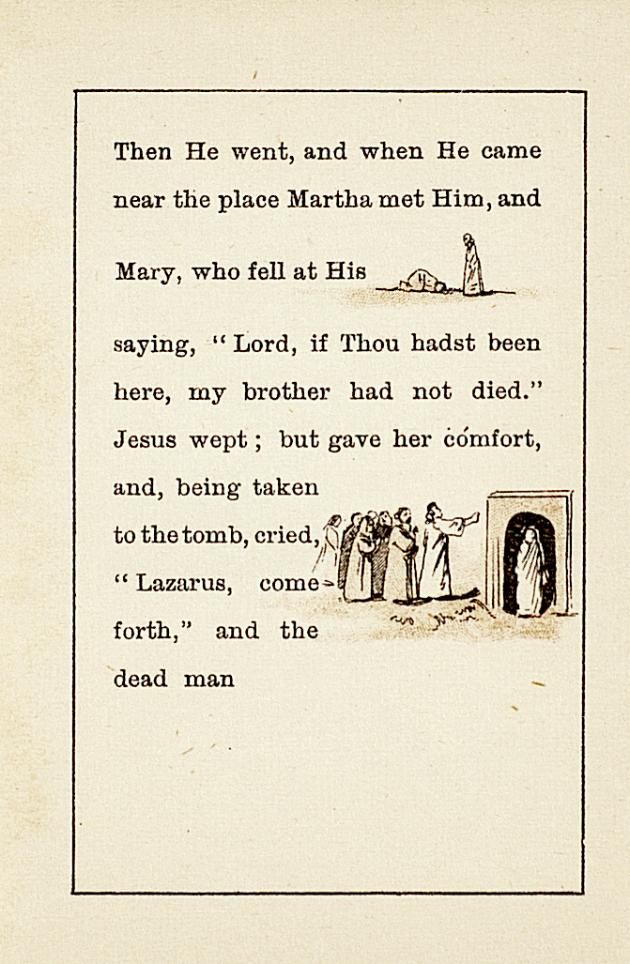Hieroglyphic Bible. New Testament Stories.
Hieroglyphic Bible. New Testament Stories.
By Sümeyye Topkara
Introduction
This blog post will focus on The Hieroglyphic Bible. New Testament Stories, a children’s bible printed in 1893 by David Bryce & Son in Glasgow and through this example, will narrate the history of hieroglyphic bibles, their purpose, and their importance in the bible history. In the last part, it will analyze the story of Lazarus from the gospels as an example.
| Categories | Bible |
| Title | Hieroglyphic Bible. New Testament Stories. |
|---|---|
| Date | [1893?] |
| Place | Glasgow, Scotland |
| Contributor(s) | Author: Federick A. Laing; Printer: David Bryce & Son |
| Language(s) | English |
| Source | University of Florida |
| Format | 91 mm |
What is a Hieroglyphic Bible?

A hieroglyphic bible was a religious educatory tool in which the keywords were replaced with small pictures to encourage children to guess the word. This way, they aim to create a more interactive and playful engagement for children to learn, even to memorize, biblical stories or maxims.
The picture on the left is a great example: This frontispiece is from the 1893 edition of Old and New Testament Stories by David Bryce & Son. It depicts two children reading a hieroglyphic bible and the page they are reading is a hymn, and it can be deciphered as “Thy Word is a lamp unto my feet and a light unto my path.”
The Non-Playful History and Purpose of Hieroglyphic Bibles
Almost every single description of hieroglyphic bibles is sure of one fact: hieroglyphic bibles were popular in the English language in the 18th and 19th centuries[1]. The first known copy of a hieroglyphic bible was Die Geistliche Herzens-Einbildungen in zweihundert und fünffzig biblischen Figur-Sprüchen vorgestellet.[2] A 2 volume hieroglyphic bible published in Ausgburg, Germany in 1684 and 1692[3]. The first hieroglyphic bible in English A Curious Hieroglyphick Bible was printed in 1783, in London. [4] In the following century, many similar books were published in the United Kingdom and the United States of America. These Bibles were created with the idea of teaching the bible to young children in a fun and interactive way so that the teachings and stories will inspire them to further study the bible. It is possible to see the traces of this idea generally in prefaces written by the publishers, almost as a tradition since the Ausgburg bible which states on the title page: “For all pious Hearts and for the Youth that loves Virtue, (…) and for the Simple, as an attractive representation, and easy understanding and profitable comprehension.”[5] Similarly, the first English edition’s preface claims that this book is for youth’s amusement and is a great encouragement to pursue the study of Old and New Testaments[6]. In New Testament Stories, we see this message directly in the frontispiece quotes from Timothy 3.15, King James Version: “That from a child thou hast known the holy scriptures.”

Raising Hieroglyphic Bibles from the Dead: David Bryce & Son Edition
Publisher David Bryce & Son were interested in the idea and history of hieroglyphic bibles. In 1893, they published Old Testament Stories and New Testament Stories by Frederick A. Laign in two books. In the same year, they published a compiled one as well. In 1894, they published Hieroglyphic Bibles their origin and history A hitherto Unwritten Chapter of Bibliography With Facsimile Illustrations by Alexander Clouston and A New Hieroglyphic Bible told in Stories by Frederick A. Laing. While the first 316 pages of this book are about the history of hieroglyphic bibles, the rest are the Old and New Testament Stories prepared by Frederick A. Laign.
The preface of New Testament Stories written by either the publisher or the author shows a deep knowledge of hieroglyphic bible history, most likely thanks to Clouston’s work. They praise these bibles by emphasizing their popularity at the beginning of the century as an example of their effectiveness and state that they “have gone out of vogue long since.” Then, they criticize old hieroglyphic bibles’ pictures: “For the most part, the woodcuts, or “hieroglyphs,” in place of certain words, were of a rude (and sometimes even ludicrous) description, while the plan of presenting only detached passages could have conveyed but a fragmentary kind of instruction.[7]” They added facsimiles from these old bibles at the end of the book so that the reader may distinguish their design from the previous ones, which they also very clearly describe in the “Preface”: “The present work, as may be seen at a glance, is largely formed on a very different plan: the youthful reader has here, in simple language, a series of the more notable and striking scenes and narratives in the Scriptures, with a modified form of the old ‘‘hieroglyphs,” produced in a style of colour-printing which it is hoped will prove attractive to many little ones.”[8] Thus, differences from the old ones are a simpler language and a colored version of old hieroglyphs. However, the attempt to bring hieroglyphic bibles back into the fashion and critical reading of previous hieroglyphic bibles make this edition also a careful reading of bible history and a bibliographically aware edition.
The below example compares David Bryce & Son edition with a Scriber & Welford 1888 edition, which was the facsimile of Dean Murray Edition from 1819. It is possible to see that David Bryce edition narrates a story rather than being a direct quotation from the bible. It is straightforward, and it uses hieroglyphs within the context of the stories rather than plain words, which makes it easier to understand the meaning behind the picture. Another noticeable difference in David Bryce’s edition is the lack of a key below the page. Almost all hieroglyphic bibles have a similar key under the page to help the reader, while Bryce edition does not have one.
The Example of the Story of Lazarus
The story of Lazarus is a short and good example of Bryce & Son edition of the Hieroglyphic Bible. The first thing that we can see while the original story is more than 40 lines, it is only six sentences here. When we look at the pictures, we see that their meanings are contextual rather than symbolic. The reader has to guess that Lazarus is sick in the first hieroglyph or is rising from the grave in the last one, which helps readers to engage with the meaning more than just guessing the word that the hieroglyph symbolizes.


[1] “52 Weeks of Inspiring Illustrations, Week 15: ‘A New Hieroglyphical Bible, for the Amusement & Instruction of Children’ (1794) – Special Collections Blog”; “Hieroglyphic Bible”; “Other Bibles – Library of Congress Bible Collection | Exhibitions – Library of Congress.”
[2] Clouston and Laing, Hieroglyphic Bibles. 126.
[3] “Melchior Mattsperger Compiles the First Hieroglyphic Bible for Children : History of Information.”
[4] “Melchior Mattsperger Compiles the First Hieroglyphic Bible for Children : History of Information.”
[5] Clouston and Laing, Hieroglyphic Bibles, 126.
[6] Clouston and Laing, Hieroglyphic Bibles, 8.
[7] Laign, Hieroglyphic Bible. New Testament Stories.
[8] Laign, Hieroglyphic Bible. New Testament Stories.
Bibliography
“52 Weeks of Inspiring Illustrations, Week 15: ‘A New Hieroglyphical Bible, for the Amusement & Instruction of Children’ (1794) – Special Collections Blog.” https://special-collections.wp.st-andrews.ac.uk/2012/10/01/52-weeks-of-inspiring-illustrations-week-15-a-new-hieroglyphical-bible-for-the-amusement-instruction-of-children-1794/.
Clouston, William Alexander, and Frederick A. Laing. Hieroglyphic Bibles: Their Origin and History; a Hitherto Unwritten Chapter of Bibliography, with Facsimile Illustrations. David Bryce & Son, 1894. https://ufdc.ufl.edu/uf00081986/00001
Laign, Frederick A. Hieroglyphic Bible. New Testament Stories. Glasgow: David Bryce & Son, 1893.
Hieroglyphic Bible Being a Careful Selection of the Most Interesting and Important Passages in the Old and New Testaments; Regularly Arranged from Genesis to Revelations. Scriber & Welford, 1888. https://ufdc.ufl.edu/UF00055480/00001/citation
“Melchior Mattsperger Compiles the First Hieroglyphic Bible for Children : History of Information.” Accessed November 30, 2023. https://www.historyofinformation.com/detail.php?id=3103.
National Library of Scotland. “Hieroglyphic Bible.” Web page. https://www.nls.uk/collections/rise-of-literacy/hieroglyphic-bible/.
“Other Bibles – Library of Congress Bible Collection | Exhibitions – Library of Congress.” Web page. https://www.loc.gov/exhibits/bibles/interactives/more/other15.html.



